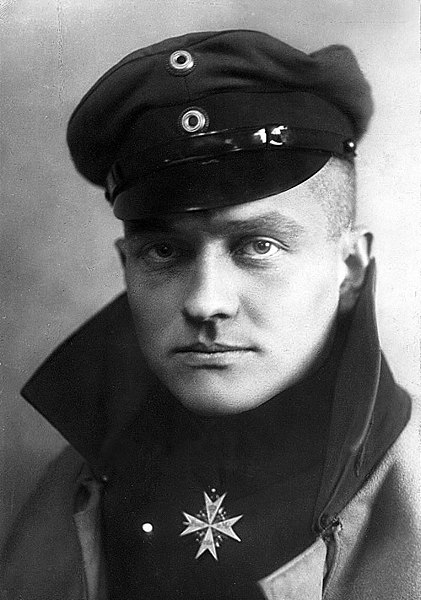Manfred Albrecht Freiherr von Richthofen, also known as Baron von Richthofen or the Red Baron, was a fighter pilot with the German Air Force during World War I and is regarded as the war’s ace-of-aces, with an official tally of 80 aerial victories. He is included in the Top celebrity aces during world war I.
Richthofen began his military career as a cavalryman before joining the Luftwaffe in 1915 and becoming one of the first members of the fighter squadron Jagdstaffel 2 in 1916. He quickly rose through the ranks of fighter pilots, eventually becoming the commander of Jasta 11 in 1917. Later, he led the larger fighter wing Jagdageschwader I, also known as “The Flying Circus” or “Richthofen’s Circus” due to the bright colors of its aircraft and perhaps also because of the way the unit was transferred from one area of Allied air activity to another – moving like a traveling circus and frequently pitching tents on makeshift airfields. By 1918, Richthofen had become a national hero in Germany, and his enemies admired him.
On April 21, 1918, Richthofen was shot down and killed near Vaux-sur-Somme. There has been much discussion and debate about various aspects of his career, particularly the circumstances surrounding his death. He is still one of the most well-known fighter pilots of all time, and his story has been told in numerous books, films, and other forms of media.
The World War 1
When World War I broke out in 1914, Manfred von Richthofen was twenty-two years old. On the western front, his first job during the war was leading reconnaissance patrols. The fighting on the western front, however, quickly devolved into trench warfare. In the trenches, the cavalry had little use, and Manfred was soon delivering messages behind enemy lines. Manfred volunteered to work as an observer on airplane reconnaissance missions because he wanted to be more involved in the war. He flew alongside pilots, spotting enemy troops, reading maps, and shooting down enemy planes with his machine gun.
Manfred’s Plan to Become a Pilot
Manfred decided to train to become a fighter pilot after a chance encounter on a train with the famous fighter pilot Oswald Boelcke. He worked hard and flew solo for the first time on October 10, 1915. He earned his fighter pilot certification by the end of the year. Manfred flew missions against enemy aircraft throughout 1916. He soon joined the Fighter Squadron, an elite group of fighter pilots led by Oswald Boelcke. Boelcke taught Manfred everything he knows about flying a fighter jet. On September 17, 1916, he won his first official victory. When a pilot shoots down an enemy plane, it is considered a victory. Many victories over enemy territory did not count as official victories because they needed to be confirmed by witnesses. There are a lot of famous pilots of World War I and indeed, Manfred is one of them.
Manfred quickly rose to become one of Germany’s most decorated fighter pilots. He wasn’t a particularly good pilot, but he was a superb shooter who took few risks and employed excellent tactics. While attacking an enemy from above, he frequently used the sun to hide from view. While on the attack, he used other pilots and planes to protect him from being attacked from behind or to the side.
The Red Plane
Manfred began painting his plane color red in January 1917. His squadron soon followed suit, painting a portion of their planes red. He rose through the ranks of the Flying Circus, a group of Germany’s best fighter pilots. They fought in major battles across the western front. With 80 confirmed kills, Manfred became the best fighter pilot in World War I. In July 1917, he was shot down, but he survived and returned to battle later that year.
Manfred became a war hero on both sides of the conflict and was considered one of Germany’s top war heroes. He was dubbed the Red Baron by the British, and he is still known by that moniker. To help break the German people’s morale, the Allies wanted to shoot down the Red Baron.
The Red Baron is shot
The Red Baron was still Manfred Albrecht Freiherr von Richthofen, despite his growing legend. He may have been a wealthy aristocrat and a war hero in his homeland, but he was a man-made of flesh and blood behind the trophies, bravado, and the stick of his plane. Richthofen was reminded of this on July 6, 1917, when a British F.E.2 biplane gave him a friendly reminder.
Richthofen’s red fighter was pierced by a single bullet, which grazed his head and fractured his skull. The impact of the round knocked him out and left him blind and paralyzed, but the seasoned pilot regained his senses and managed a rough landing behind German lines before the plane crashed. Richthofen suffered from severe headaches, nausea, and depression as a result of the injury, but it wasn’t enough to keep him from fighting. Despite doctors’ orders not to return to active duty, the Red Baron terrorized the skies once more the following month.
Richthofen upgraded to a more acrobatic Fokker Dr.1 triplane not long after returning to duty–the plane that would become synonymous with the Red Baron legend. Despite. He returned to the fight with renewed vigor after his injuries, quickly racking up kills in his new fighter. By April of 1918, the Red Baron had racked up an incredible 80 kills.
The Red Baron’s good fortune runs out.
Richthofen led his “Flying Circus” into battle over Vaux-sur-Somme in northern France on April 21, 1918, one day after shooting down his 80th Allied aircraft. They were met by a barrage of British fighters, and Richthofen gave chase to a Sopwith Camel piloted by Wilfrid May, a young and inexperienced Brit. The infamous German pilot was spotted by a group of Australian soldiers as the blood-red Fokker tri-plane zoomed low over Allied infantry troops.
As the Red Baron passed over their heads, they opened fire. At the same time, May’s squadron leader, Canadian Captain Arthur Roy Brown, took up position behind the red-painted fighter and pulled the trigger, letting loose a hail of gunfire into the Fokker triplane’s tail.
Richthofen was shot in the torso by a single round from an unknown gun. Richthofen, unlike the previous time he was hit, was unable to recover the plane. He slammed into a nearby beet field, bleeding out and dying while still strapped to his seat. The Red Baron, like his flying ace tutor Boelcke before him, died at the age of 25.
Germany would sign the Treaty of Versailles seven months later, admitting defeat to the Allies.

